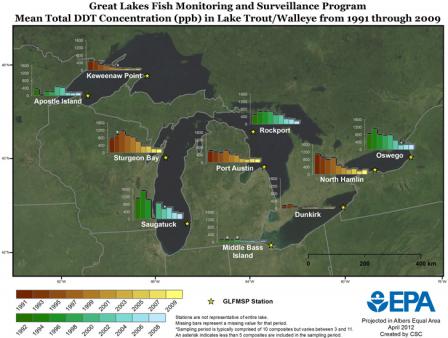Great Lakes Open Lakes Trend Monitoring Program: Dichlorodiphenyltrichloroethane (DDT)
 Mean total DDT concentration (ppb) in lake trout/walleye from 1991 through 2009.In 1992, the U.S. banned the use of Dichlorodiphenyltrichloroethane (DDT), a synthetic insecticide. DDT levels in the Great Lakes top predator fish have declined since the chemical became illegal. Lake DDT levels remain well below the 1987 Great Lakes Water Quality Agreement goal all through the Great Lakes basin.
Mean total DDT concentration (ppb) in lake trout/walleye from 1991 through 2009.In 1992, the U.S. banned the use of Dichlorodiphenyltrichloroethane (DDT), a synthetic insecticide. DDT levels in the Great Lakes top predator fish have declined since the chemical became illegal. Lake DDT levels remain well below the 1987 Great Lakes Water Quality Agreement goal all through the Great Lakes basin.
Based on information collected at Environment Canada monitoring locations, yearly rates drop by 6.8% in Lake Superior, 7.1% in Lake Huron, 7.5% in Lake Erie, and 7.3% in Lake Ontario. This dip seems to be in line with past rate drops. Yearly rates drop using U.S. EPA information are a little lower at 4.5% in Lake Superior, 5.9% in Lake Michigan, 5.9% in Lake Huron, 6.0% in Lake Erie, and 6.7% in Lake Ontario. Rate drops at the U.S. monitoring stations seem to be falling faster in Lakes Michigan, Huron, and Ontario compared to the past, while rates remain level with past trends in Lakes Superior and Erie.
